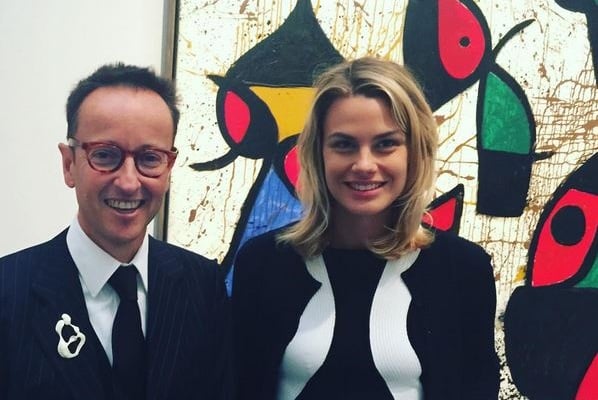
Zurich’s Galerie Gmurzynska opened its survey of Surrealist master Joan Miró’s work this past weekend with an adventurous performance by the artist’s grandson, Joan Punyet Miró, entitled Surrealism and Dadaism, the Awakening, and involving nudity, gun fire, and a Harley-Davidson.
The work of Joan Miró is instantly recognizable, despite the many evolutions the artist went through in his lifetime. This exhibition—which was 10 years in the making—brings together many elements of Miró’s oeuvre, thus highlighting his rebelliousness and foresight as an artist.
Included in the exhibition are examples of Miró’s painting, bronze sculpture, collage, textiles, and drawings. It’s rare that a survey of a widely-exhibited artist still succeeds in providing new insights but the combination of works, especially the inclusion of textile based works, make this a show worth seeing.
Joan Miró, Untitled (titled Personnage by Pierre Matisse) (1938)
Photo: courtesy of Galerie Gmurzynska
CEO and co-owner of Galerie Gmurzynska—which this year celebrates its 50th anniversary—Mathias Rastorfer, agreed to host the performance after a chat and a handshake with Punyet Miró at Art Basel Hong Kong earlier this year.
Punyet Miró has spent his career writing on and researching his grandfather’s work and was inspired to put on the performance after being repeatedly bored by museum exhibitions. He wanted to encourage viewers to remember just how groundbreaking the Modern art movement really was, he told artnet News ahead of the event.
Joan Miró, Femme, (1968)
Photo: courtesy of Galerie Gmurzynska
“Museums are repeating themselves over and over again,” Miro explained, not mincing his words. “There are too many curators and directors who repeat themselves. So you have lost the magic and the feeling. They might know more about my grandfather than I do, but they have no right to create exhibitions that feel like a trip to the dentist.” Ouch!
“Going to a museum shouldn’t feel like going to the dentist, after leaving an exhibition you should feel as though you have changed,” he added.
Punyet Miró went on to explain that he felt artists today were not able to be as radical as they perhaps should be, due to the pressure to achieve repeated financial success.
“It’s not just museums, it’s also galleries, and art fairs, and so on… We’ve put art into a marketing concept and it has all become about goods, essentially,” Rastorfer added. “When you deal with the Modern, very often you have the perception that people come and think ‘Well, I know that already,’ so how do you make people look again?”
Rastorfer and Punyet Miró see eye to eye on the matter. “What Joan is attempting, and what we are attempting to do, is to shock a little bit so people wake up. Emotions are an integral part of art, so if you separate that it becomes just about goods,” Rastorfer explained.
Joan Miró, Metamorphose (1936)
Photo: courtesy of Galerie Gmurzynska
After the opening, guests headed over to the after party at Razzia, a cinema converted into a restaurant, to see Punyet Miró’s performance which he promised would “Rock you, baby!”
He rode into the plush restaurant on a Harley Davidson to the sound of Born to be Wild by Steppenwolf, dressed entirely in florescent pink, and started to talk through Miró’s work and approach, as he sees it.
There was an awkwardness in the audience—which included Catherine Deneuve—as Punyet Miró proceeded to fire what appeared to be a genuine pistol (filled with blanks) into the air, weep with emotion when describing his grandfather’s practice, and finally, strip naked, cover himself in neon paint and press himself into a giant canvas.
Catherien Deneuve and Joan Punyet Miró
Photo: courtesy Galerie Gmurzynska
He peppered the over-the-top happening with personal and conceptual anecdotes about his beloved grandfather, which were both interesting and amusing.
He then concluded with a message, “artists aren’t supposed to make money, they are supposed to make history,” citing the competition between Marc Chagall, Pablo Picasso, and his grandfather to create new artistic techniques and styles up until the end of their lives.
Deneuve and Rastorfer
Photo: courtesy Galerie Gmurzynska
The eponymous exhibition at Gmurzynska, around half of which is on sale, coincides with “Joan Miró: Wall, Frieze, Mural” at the Kunsthaus in Zurich.
Joan Miró will be on view at Galerie Gmurzynska until January 16 2016